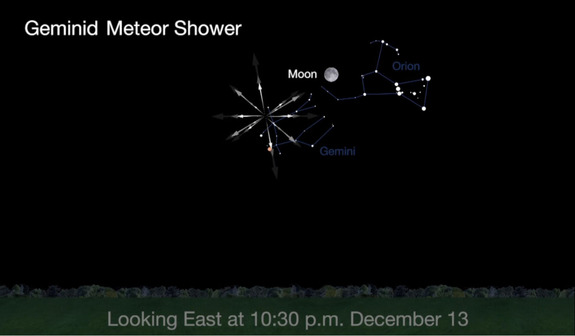Geminid meteor showe
The Geminid meteor shower, a favorite annual night sky event among stargazers, peaks tonight (Dec. 13), and you can watch the action live online if Mother Nature spoils your view.
The Slooh Community Observatory will host a live webcast featuring views of the "falling stars" from Slooh's flagship observatory at the Institute of Astrophysics of the Canary Islands, as well as locations in Connecticut (where Slooh is based), the United Kingdom and Sweden. The broadcast will start at 8 p.m. EST (midnight GMT) on Slooh's website.
You can also watch the Geminid meteor shower webcast here at Space.com, courtesy of Slooh. The Geminids will take place during December's full "supermoon" — meaning the full moon is also at its closest point to Earth in its 27-day orbit — but Slooh astronomers are still expecting a good show since the meteors themselves are bright. [Geminid Meteor Shower 2016: When, Where & How to See It]

This NASA sky map shows the location of the Geminid meteor shower source in the eastern night sky on Dec. 13, 2016 during the shower's peak, which will be washed out by the bright full moon nearby.
Credit: NASA/JPL-Caltech
"Not only will viewers be able to see meteors whizzing by these many low light cameras, they'll also get a chance to hear the [bits] of space debris as they collide with Earth’s atmosphere, thanks to Slooh's special radio feed," Slooh officials said in a statement.
During the broadcast, astronomers and other experts will discuss the strange asteroid known as 3200 Phaethon that causes the Geminids. Recurring meteor showers occur when Earth passes through a trail of debris left behind by a comet, asteroid or other space rock. 3200 Phaethon could have been a comet or a piece of a comet in the past. Because the asteroid is rocky (rather than icy), the particles that fall through Earth's atmosphere and burn up during the Geminid meteor shower are brighter and burn longer when they fall through the atmosphere.
The Slooh experts will explain why the Geminids are active at the same time every year. Because the Geminids seem to emanate from the constellation Gemini, the experts will also discuss the mythology surrounding the Gemini twins, Castor and Pollux. Viewers will also get a tutorial on how to take their own meteor photographs.
Slooh's host for the broadcast will be Gerard Monteux, who has just joined the organization after time at ESPN and NBC Sports (where he went by the name Bill Patrick.)
“It’s an honor and a privilege to be working alongside some of the most respected people in the world of astronomy, astrophysics and engineering," Monteux said in a statement. "You could say I'm 'star-struck.'"
“It’s an honor and a privilege to be working alongside some of the most respected people in the world of astronomy, astrophysics and engineering," Monteux said in a statement. "You could say I'm 'star-struck.'"
Monteux will be joined by Slooh astronomers Paul Cox and Eric Edelman, as well as journalist Bob Berman and Slooh's human spirit correspondent, Helen Avery. Viewers can participate in the broadcast — and get the chance to win a copy of the new book "The Saturn Above It: An Anthology of Short Fiction About Space" — by tweeting @Slooh or participating in the live chat on Slooh's Facebook page.
Comments
Post a Comment